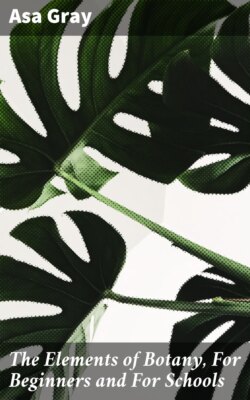The Elements of Botany, For Beginners and For Schools

Реклама. ООО «ЛитРес», ИНН: 7719571260.
Оглавление
Gray Asa. The Elements of Botany, For Beginners and For Schools
The Elements of Botany, For Beginners and For Schools
Table of Contents
PREFACE
Section I. INTRODUCTORY
FOOTNOTES:
Section II. FLAX AS A PATTERN PLANT
Section III. MORPHOLOGY OF SEEDLINGS
Section IV. GROWTH FROM BUDS: BRANCHING
Section V. ROOTS
Section VI. STEMS
Section VII. LEAVES
§ 1. LEAVES AS FOLIAGE
§ 2. LEAVES OF SPECIAL CONFORMATION AND USE
§ 3. STIPULES
§ 4. THE ARRANGEMENT OF LEAVES
Section VIII. FLOWERS
§ 1. POSITION AND ARRANGEMENT OF FLOWERS, OR INFLORESCENCE
§ 2. PARTS OR ORGANS OF THE FLOWER
§ 3. PLAN OF FLOWER
§ 4. MODIFICATIONS OF THE TYPE
§ 5. ARRANGEMENT OF PARTS IN THE BUD
Section IX. STAMENS IN PARTICULAR
Section X. PISTILS IN PARTICULAR
§ 1. ANGIOSPERMOUS OR ORDINARY GYNŒCIUM
§ 2. GYMNOSPERMOUS GYNŒCIUM
Section XI. OVULES
Section XII. MODIFICATIONS OF THE RECEPTACLE
Section XIII. FERTILIZATION
§ 1. ADAPTATIONS FOR POLLINATION OF THE STIGMA
§ 2. ACTION OF POLLEN, AND FORMATION OF THE EMBRYO
FOOTNOTES:
Section XIV. THE FRUIT
Section XV. THE SEED
Section XVI. VEGETABLE LIFE AND WORK
§ 1. ANATOMICAL STRUCTURE AND GROWTH
§ 2. CELL-CONTENTS
§ 3. ANATOMY OF ROOTS AND STEMS
§ 4. ANATOMY OF LEAVES
§ 5. PLANT FOOD AND ASSIMILATION
§ 6. PLANT WORK AND MOVEMENT
Section XVII. CRYPTOGAMOUS OR FLOWERLESS PLANTS
FOOTNOTES:
SECTION XVIII. CLASSIFICATION AND NOMENCLATURE
§ 1. KINDS AND RELATIONSHIP
§ 2. NAMES, TERMS, AND CHARACTERS
§ 3. SYSTEM
SECTION XIX. BOTANICAL WORK
§ 1. COLLECTION, OR HERBORIZATION
§ 2. HERBARIUM
§ 3. INVESTIGATION AND DETERMINATION OF PLANTS
§ 4. SIGNS AND ABBREVIATIONS
FOOTNOTES:
ABBREVIATIONS OF THE NAMES OF BOTANISTS
GLOSSARY AND INDEX,
Отрывок из книги
Asa Gray
Published by Good Press, 2019
.....
31. Germinating Embryo supplied from a Deposit outside of Itself. This is as common as the other mode; and it occurs in all degrees. Some seeds have very little of this deposit, but a comparatively large embryo, with its parts more or less developed and recognizable. In others this deposit forms the main bulk of the seed, and the embryo is small or minute, and comparatively rudimentary. The following illustrations exemplify these various grades. When an embryo in a seed is thus surrounded by a white substance, it was natural to liken the latter to the white of an egg, and the embryo or germ to the yolk. So the matter around or by the side of the embryo was called the Albumen, i.e. the white of the seed. The analogy is not very good; and to avoid ambiguity some botanists call it the Endosperm. As that means in English merely the inwards of a seed, the new name is little better than the old one; and, since we do not change names in botany except when it cannot be avoided, this name of albumen is generally kept up. A seed with such a deposit is albuminous, one with none is exalbuminous.
32. The Albumen forms the main bulk of the seed in wheat, maize, rice, buckwheat, and the like. It is the floury part of the seed. Also of the cocoa-nut, of coffee (where it is dense and hard), etc.; while in peas, beans, almonds, and in most edible nuts, the store of food, although essentially the same in nature and in use, is in the embryo itself, and therefore is not counted as anything to be separately named. In both forms this concentrated food for the germinating plant is food also for man and for animals.
.....